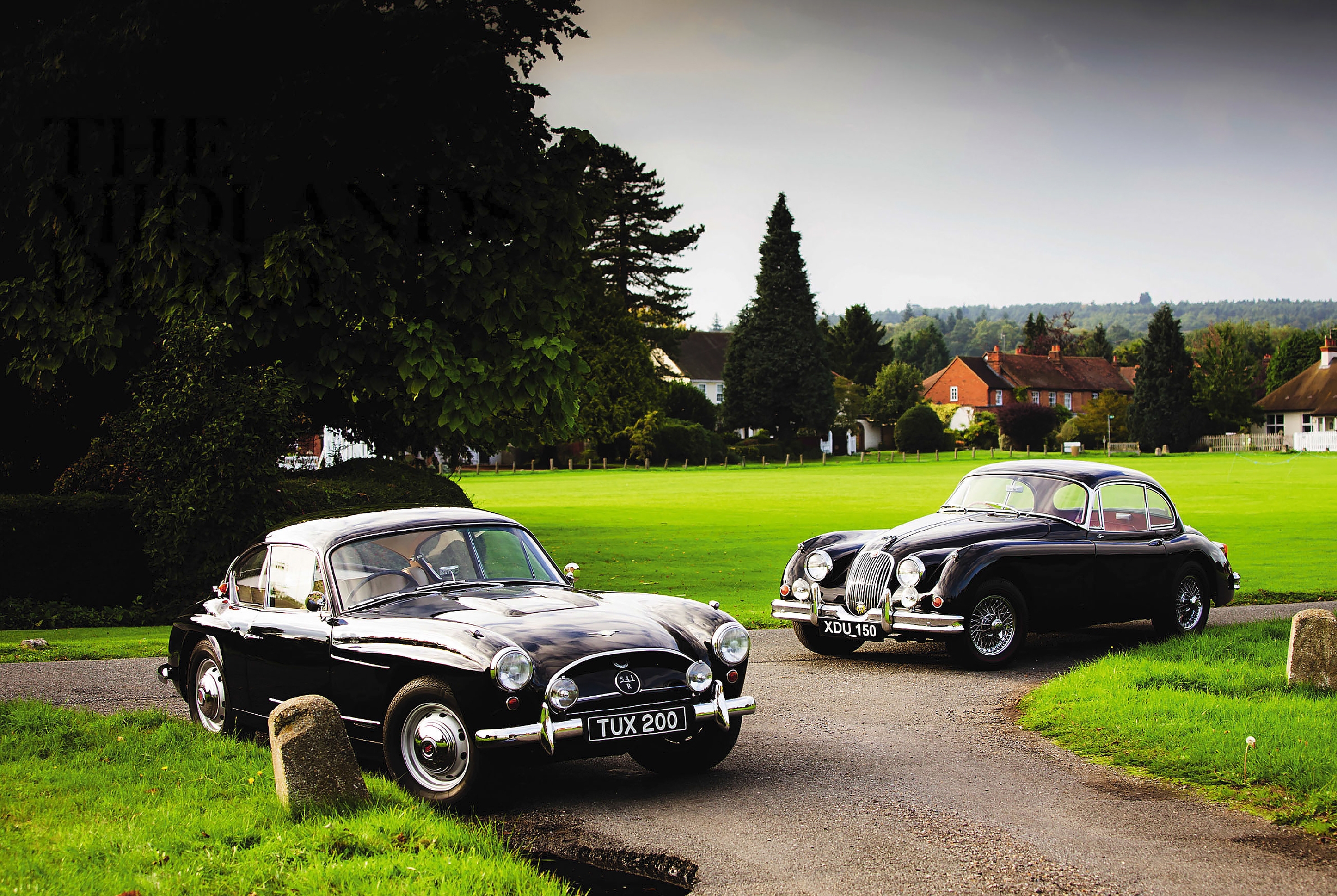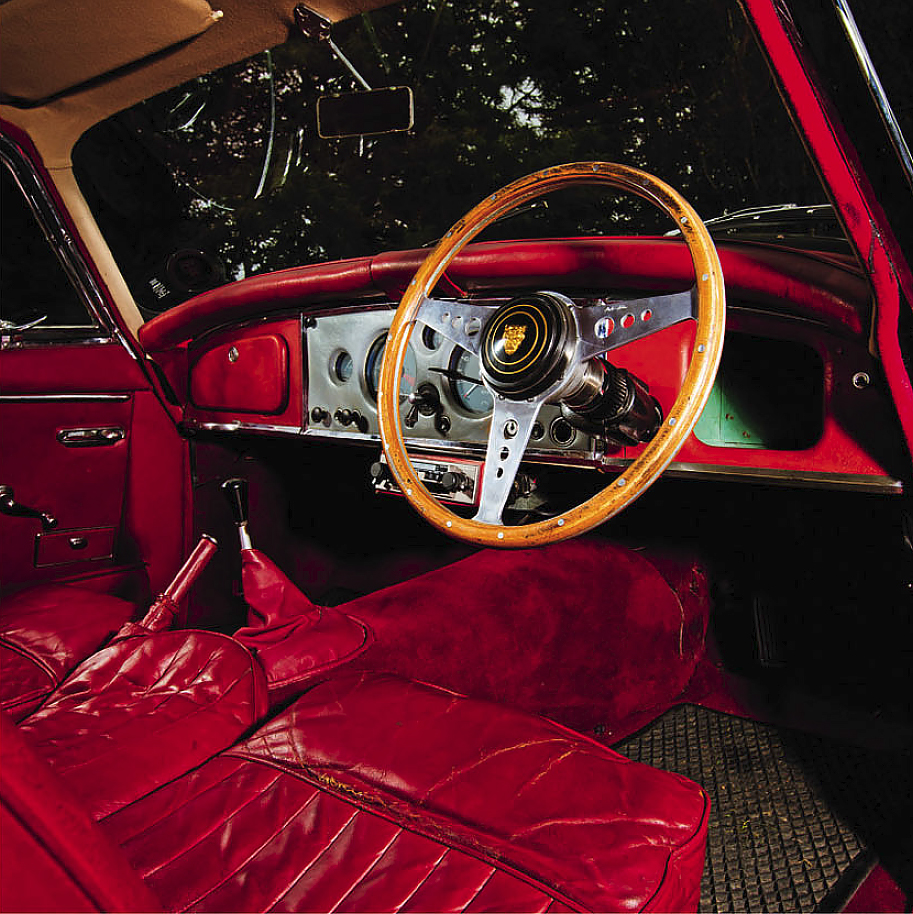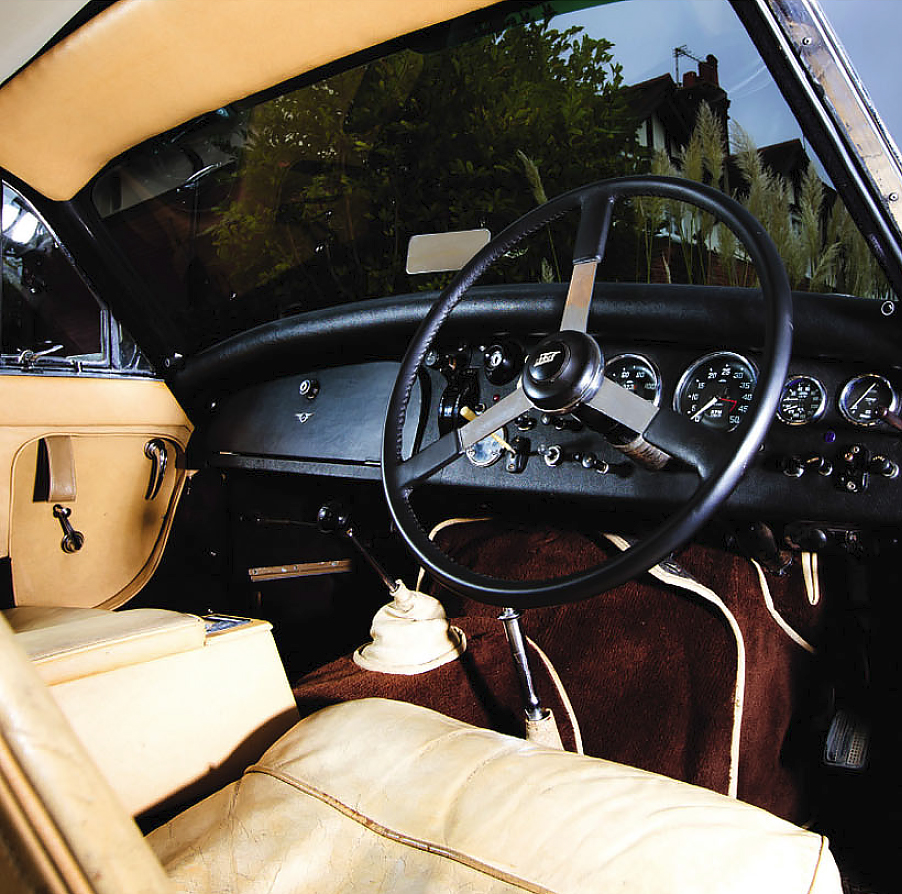
The midlands derby. With the 541, Jensen threw down a gauntlet to Jaguar. But can a 541R really trade punches with an XK150? Jon Pressnell adjudicates. Photography Malcolm Griffiths. Golden years: how do you define them? For Jaguar you could easily cite the 1960s, the decade that began with the launch of the E-type, arguably the most sensational sports car of all time, and closed with the bringing into production of that finest of saloons, the original XJ6. But the 1950s was the period when Jaguar achieved most. Its XKs conquered the United States, its big saloons became a sub-Bentley reference, and its smaller 2.4 and 3.4 annihilated both mainstream and specialist opposition. All this, plus five Le Mans victories: no wonder William Lyons picked up a knighthood in 1956.

The Jaguar is coloured – no, defined – by that magnificent hemi-head twin-cam engine.

Underpinning everything was a simple fact. Jaguar made cars people wanted: good-looking, smartly trimmed and blessed with strong performance – at a price that made the competition blanche. So the notion of comparing an XK150 coupe with a Jensen 541 might seem laughable. In 1958, the Jensen cost £2866 in top-spec Jensen 541R form, when the 3.4-litre Jaguar in its most common Special Equipment guise – delicious 210bhp twin-cam engine and all – clocked in at a mere £2007 with optional overdrive. For the 43% more asked by Jensen, you got a glass-fibre body and nothing more exotic than a 4-litre pushrod straight-six normally found in Austin lorries or punting local dignitaries around in their Vanden Plas limousines. Game over?
Let’s put price aside for a moment – price when new, that is. The two cars are otherwise surprisingly comparable. They measure roughly the same, they weigh roughly the same, and they offer a maximum speed a whisker over 120mph. The similarities seem all the greater when you look at our two black-finished featured cars, the 541R of Mark Bird and the uprated XK150 SE kindly supplied by Racing Green Cars.
There’s a school of thought that considers the last of the XKs as the flabby also-ran of the series, relative in particular to the lithe and tautly drawn XK120. These same people probably regard the 3000 MkIII as the most degenerate of the Big Healeys. I beg to differ. For me, the XK150 has a harmony and a broad-chested elegance to its lines – and that’s leaving aside the fact that it’s the fastest of the breed. It should also be pointed out that in size it’s only an inch longer than an XK140 and is the same width, despite an extra 4in of shoulder room in the cockpit.
The Jensen lacks the easy fluidity of the Jaguar, but it is a striking and not unattractive design, with its Mercedes-like wing blisters, swivelling air-intake flap and aggressively wraparound Plexiglas rear window. It looks lean and low – and at 2in less tall than the Jaguar the eye does not lie. Functionally, too, the 541 almost certainly has it over the XK: Jensen stylist Eric Neale set out to produce an aerodynamically efficient design – never a William Lyons preoccupation – and by skill or chance he succeeded. Tested in the Austin wind-tunnel, the prototype apparently registered a highly laudable 0.365 coefficient of drag with the air-intake flap closed a figure on a par with that of a late Citroen DS, not to mention one trumping such later exotica as the Ferrari Daytona.

Above, left-right: this XK is uprated to triple-carb ‘S’ tune; famous lea per; leather-clad dash in place of predecessor’s veneer; rear cushions lift out; boot strake adds dynamism and celebrates Le Mans wins; Jag handles and rides well. Right: non-original Moto-Lita aids modern feel of steering; column adjusts.

In terms of their mechanicals, neither car holds any surprises. Announced in May 1957 as a fixed-head and drophead (the roadster came in March ’58), the XK150 is essentially a rebodying of the XK140 – dropping the archaic split windscreen along the way. It thus has the second generation of the box-section XK chassis, with rack-and-pinion steering and telescopic rear dampers, and with the engine moved forward to create more cockpit room and promote more stable understeer-biased handling. The double wishbone torsion-bar front suspension (again with telescopics) also remains unchanged from that of the XK140. Where the 150 differs is in having four-wheel servo-assisted Dunlop discs although in theory a base 190bhp model was offered with all-drum brakes.
The engine marks a modest step forward, too. The XK150’s SE ‘Blue Tap’ unit offers the same horsepower as the engine of the XK140 SE, but maximum torque – up by 3lb ft, to 216 – comes in a whole 1000rpm lower, at 3000rpm, thanks to a combination of relatively small inlet valves and the larger exhaust valves of the C-type head. A triple-carb XK150 S became available in 1958, initially for export, and the Racing Green car was up-gunned in 1960 to this 250bhp spec – at the time when Jaguar had added the option of 220bhp and 265bhp 3.8-litre engines for that model year.
{CONTENTPOLL [“id”: 6]}
The Jensen is rigorously orthodox, if you look beyond its pioneering glassfibre body, which can be claimed to be the world’s first production four-seater reinforced-plastic shell. Conscious of the possible frailties of this material, Jensen resolved to give the 541 robust underpinnings, so it designed a new ladder-frame chassis. Featuring four round-tube crossmembers and beefy 5in-diameter side rails, it was intended to be stiff in torsion – and so it proved when it was tested for resistance to twist. It’s unlikely that the preceding Interceptor’s elongated Austin A70 frame would have been anything like as rigid.
The Austin coil-and-wishbone front suspension was carried over from the Interceptor, albeit adapted to take telescopic dampers instead of lever-type Armstrongs. Also inherited from the older car was the 3993cc Austin straight-six and its matching gearbox, taking drive to a straight-forward leaf-sprung live back axle with telescopics and a Panhard rod. To provide some extra urge, the all-iron engine sported triple SU carbs, pushing power up to 117bhp.
Such, at any rate, was the initial specification when the 541 was announced at the 1953 Motor Show, trailed by the not-quite-complete alloy-bodied prototype on the Jensen stand. Production began in late ’54, and built up slowly -to the point where it was only in September ’1955 that The Autocar was able to test an example.
In October ’1956, a De Luxe version was introduced, with four-wheel Dunlop disc brakes and with all the key options of the regular 541 as standard – high-compression head, overdrive, wire wheels, twin exhaust and rev-counter. A year later, a third model joined the catalogue. The 541R had the latest version of the Austin engine, with separate inlet ports, and reverted to twin SUs; despite this, power rose to c150bhp from the estimated 130bhp – Jensen never quoted output – of the De Luxe. BMC was by then fitting only automatic gearboxes to the Vanden Plas, so Jensen switched to the same Moss ’box as used in the Jaguar. Equally significantly, the steering changed from a box to a rack, and the chassis was redesigned to take an Austin A90 front suspension cradle – meaning a backwards move to lever-arm front dampers.
To strengthen the body, the 541R also boasted blisters over the rear wings in place of the simple ‘speed’ moulding of the 541 and 541 De Luxe, and there was an extractor vent in the bonnet and one at the bottom of each front wing, while the boot hinged from the top rather than the bottom. These coachwork changes were eventually standardised on all 541s. The 541 and 541 De Luxe were phased out during ’59, leaving the 541R to carry on until the larger 541S was announced in October 1960. Later examples of the ‘R’ – all but the first 50 or so – went back to a triple-carb set-up, as on Bird’s car; seemingly this made little difference to power output.
With 546 built, of which 193 were 541Rs, the Jensen has always had rarity on its side against the more commonplace Jaguar, of which 8884 XK140s and 9395 XK150s were made over virtually an identical period. With that sort of mass-production, you might expect the Jaguar to have a better-honed cabin and for the Jensen to be prosaic – crude, even – in its presentation.
In fact, the Jaguar is surprisingly plain inside. Gone is the glossy walnut veneer of the XK140 coupe, replaced by a leather-covered dashboard and doors with top-to-bottom trim in a coarse-grained leather cloth. The seats are flat slabs, and in the rear there are just tiny lift-out cushions and backrests – and no pockets. There’s Jaguar’s usual lovely set of white-on-black Smiths dials, and the handy provision of deep full-length door pockets, but any quality is frankly skin-deep – as I can testify, having helped to carry out a full retrim of an XK. It’s all a bit smoke-and-mirrors, and doesn’t age well, as demonstrated by the balding flocked cardboard in the glovebox.

Above, left-right: triple- carb ‘six’ good for about 150bhp; rear has proper seat; hints of Mercedes in wing flourishes; recessed door furniture; signature swivelling intake flap; odd indicator on rear pillar; 541 needs more effort to hustle but handles tidily. Left: dash business like, with adjustable column.

The Jensen again does without wood garnishing, and has an understated leather cloth-covered dashboard with British Jaeger dials that are positioned to be more easily readable than those of the XK. The seats are better-shaped buckets, and an auxiliary cushion can be slid behind the covering of the front seats to give extra lumbar support – prompted, so it is said, by one of the Jensen brothers suffering from back trouble. More to the point, the 541 has two nicely shaped rear seats that can happily accommodate reason-ably sized children. There are also some rather charming details that make you forgive the odd exposed screw head: green celluloid sunvisors that slide out of a padded cant rail, for example, and handles set into a recess in the door trim. It’s a genuinely pleasing and practical cabin, and certainly not home-made in feel.
It’s on the road, however, that the real differences between the two cars emerge. The Jaguar is coloured – no, defined – by that magnificent hemi-head twin-cam. Bassy, growly, rugged, howling, it marries instantly accessible smooth- revving power with hefty low-down torque. Despite a relatively high level of tune, it’s in no way fickle, yet it’s fair to say that it’s not at its best trickling through Surrey rush-hour traffic.
If you want to cut-and-thrust, the XK will rise to the occasion; equally, you can just keep it in fourth and drop in and out of overdrive, making use of the surging acceleration that’s still available in top, even from low speeds. On the motorway you don’t just give nothing away to moderns: you can best them with disdain. Despite legend, the Moss gearbox helps rather than hinders. Yes, the synchromesh can be beaten, but there’s an agree-able mechanical feel to the closely gated and relatively long-throw change; with a firm hand, the long, slender lever just clicks into gear.
If the gearbox all the same has an old-fashioned action, the rest of the XK feels remarkably modern. The clutch is smooth and the brakes progressive, not notably heavy and most definitely effective. The steering, meanwhile, is well-oiled, judiciously weighted, and only becomes a touch heavy when manoeuvring. Chassis behaviour is exemplary, with hard cornering producing a little tyre squeal but with roll well checked. There’s a little liveliness from the suspension on undulating roads, but otherwise the XK rides with comfort.
If you had to sum up the Jensen in one phrase, you could confidently describe it as a car of beefy inputs. The generously dimensioned wheel links to steering that is weighty at low speed, though it becomes light and precise when on the move; the brakes need such a lean that you feel tempted to check that there is a servo under the bonnet; the clutch demands a similar effort. Even the gearchange is firm, and demands some elbow – despite it being the same Moss unit as in the XK. The unperturbed ride you might also feel tempted to put down to the perceived weight, which the thickness of the glassfibre mouldings could suggest to be substantial. At a kerb weight of 29.1cwt (3262lb), though, the Jensen comes in at only 36lb more than the Jaguar.

Then there’s the engine – all 7cwt of it. It’s not a revver – you wouldn’t expect it to be, with a redline at just 4250rpm. But it’s smooth, unruffled, and spools out great gobs of torque. Lazy rather than crisp, it just lugs. At 40mph there’s a mere 1250rpm on the clock in overdrive top (against 1400rpm in the Jag), and at 70mph the needle is still sitting south of 2500rpm. Changing gear quite often becomes optional: you can trickle through many roundabouts in top.

Both would get you to the South of France swiftly and enjoyably, but the Jensen would be the more relaxing.
So the Jensen’s straight-six lacks the sophisticated crackle and sparkle of the Jaguar’s XK unit, but despite its power deficit delivers ample performance, on an unrelenting surge of torque. You enjoy playing with the Jaguar while you feel inclined to sit back and cruise in the Jensen. There’s a paradox to the XK150, in that it is both softer and sharper than the Jensen: it’s less of an effort to drive but has more vim to its performance. It’s a profoundly seductive car, with that lovely engine, and with all other inputs being harmonious and in no way laborious. You’d have to be a strange person not to fall for its charms.
Both would get you to the South of France swiftly and enjoyably, but the Jensen would be the more relaxing – so long as you steered clear of the urban jungle. Also, the Jaguar is a strict two-seater. Those rear seats are purely symbolic, whereas the Jensen has generous room in the back. It also has more supportive front seats. Get used to that huge steering wheel and the Jensen cockpit is actually a better place to be.
For many people the Jaguar would be superior, but the Jensen has a greater spread of talent than you might expect. If you can live with the extra muscle needed to drive the 541, it makes a totally valid alternative to the XK. Is it a markedly less good car than the Jaguar, which could cost at least three times as much? Of course not. With rarity in its favour, it could make a fascinating wild-card proposition for those who don’t want to make the obvious choices in life.
Thanks to Jensen Owners’ Club (01625 525699; joc.org.uk); The International XK Club (01584 781588; xkclub.com); Racing Green (01252 894840; racinggreencars.com)





